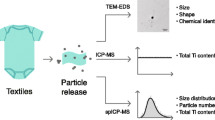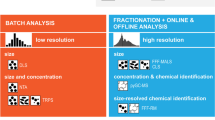Abstract
Carbon Nanotubes (CNTs) are deemed as revolutionary materials very likely to be utilized in numerous fields such as electronics, energy, and medicine, to name but a few. The emergence of this new fiber-shaped material with remarkable properties and dimensions of a few micrometers in length and a few tens of nanometers in diameter raises concerns about potential exposure of workers involved in the whole production cycle. These risks emphasize the need to develop tools allowing identifying such objects, either as isolated fibers or entangled in bundles, in situ and if possible in real time. In this context, experiments aiming at detecting potential particle release while manipulating raw CNT powders were performed at ARKEMA research center in a high safety cell dedicated to scientific experiments. Two techniques were employed. First, particle collection on TEM grids was achieved using two samplers, the first based on aspiration and the second on diffusion assisted with thermophoretic repulsion. These allowed differed analysis of single particle morphology, size and chemical composition. Second, real time multi-elemental composition of particle emission was monitored using LIBS. Eventually, though not quantitative, the coupling of TEM grid analysis with LIBS data demonstrated the possibility of real time detection of CNTs entangled in bundles.










Similar content being viewed by others
References
Amodeo T, Dutouquet C, Tenegal F, Guizard B, Maskrot H, Le Bihan O, Frejafon E (2008) On-line monitoring of composite nanoparticles synthesized in a pre-industrial laser pyrolysis reactor using laser-induced breakdown spectroscopy. Spectrochim Acta Part B 63:1183–1190
Amodeo T, Dutouquet C, Le-Bihan O, Attoui M, Fréjafon E (2009) On-line determination of nanometric and sub-micrometric particle physicochemical characteristics using spectral imaging-aided laser-induced breakdown spectroscopy coupled with a scanning mobility particle sizer. Spectrochim Acta Part B 64:1141–1152
Baron PA, Maynard AD, Foley M (2003) Evaluation of aerosol release during the handling of unrefined single walled carbon nanotube material. NIOSH DART-02-191 Rev 1.1
Carranza JE, Hahn DW (2002a) Plasma volume considerations for analysis of gaseous and aerosol samples using laser-induced breakdown spectroscopy. J Anal At Spectrom 17:1534–1539
Carranza JE, Hahn DW (2002b) Assessment of the upper particle size limit for quantitative analysis of aerosols using laser-induced breakdown spectroscopy. Anal Chem 74:5450–5454
Carranza JE, Fisher BT, Yoder GD, Hahn DW (2001) On-line analysis of ambient air aerosols using laser-induced breakdown spectroscopy. Spectrochim Acta Part B 56:851–864
Chen WX, Tu JP, Wang LY, Gan HY, Xu ZD, Zhang XB (2003) Tribological application of carbon nanotubes in a metal-based composite coating and composites 41:215–222
Cremers DA, Radziemski LJ (2006) History and fundamentals of LIBS. In: Miziolek AW, Palleschi V, Schechter I (eds) Laser-induced breakdown spectroscopy, fundamentals and applications. Cambridge University Press, Cambridge, pp 1–39
Danafar F, Fakhru’l A, Salleh MAM, Biak DRA (2009) Fluidized bed catalytic chemical vapor deposition synthesis of carbon nanotubes—a review. Chem Eng J 155:37–48
Elgrabli D, Abella-Gallart S, Aguerre-Chariol O, Robidel F, Rogerieux F, Boczkowski J, Lacroix G (2007) Effect of BSA on carbon nanotube dispersion for in vivo and in vitro studies. Toxicol 1:266–278
Elgrabli D, Floriani M, Abella-Gallart S, Meunier L, Gamez C, Delalain P, Rogerieux F, Boczkowski J, Lacroix G (2008) Biodistribution and clearance of instilled carbon nanotubes in rat lung. Part Fibre Toxicol 5:20
Hahn DW, Lunden MM (2000) Detection and analysis of aerosol particles by laser-induced breakdown spectroscopy. Aerosol Sci Technol 33:30–48
Hahn DW, Flower WL, Hencken KR (1997) Discrete particle detection and metal emissions monitoring using laser-induced breakdown spectroscopy. Appl Spectrosc 51:1836–1844
James O, Hornkohl JO, Parigger C, Lewis JWL (1991) Temperature measurements from CN spectra in a laser-induced plasma. J Quant Spectrosc Radiat Transf 46:405–411
Kim M, Park Y-B, Okoli OI, Zhang C (2009) Processing, characterization, and modeling of carbon nanotube-reinforced multiscale composites. Compos Sci Technol 69:335–342
Knowles PJ, Werner HJ, Hay PJ, Cartwright DC (1988) A2 Π – X2 Σ+ red and B2 Σ+ – X2 Σ+ violet systems of the CN radical: accurate multireference configuration interaction calculations of the radiative transition probabilities. J Chem Phys 89:7334–7343
Lyyränen J, Backman U, Tapper U, Auvinen A, Jokiniemi J (2009) A size selective nanoparticle collection device based on diffusion and thermophoresis. J Phys (Conf Ser) 170:012011
Ma-Hock L, Treumann StraussV, Brill S, Luizi F, Mertler M, Wiench K, Gamer AO, Van Ravenzwaay B, Landsiedel R (2009) Inhalation toxicity of multiwall carbon nanotubes in rats exposed for 3 months. Toxicol Sci 112:468–481
Mark D (2007) Occupational exposure to nanoparticles and nanotubes. In: Hester RE, Harrison RM (eds) Nanotechnology: consequences for human health and the environment. The Royal Society of Chemistry, Cambridge, pp 50–80
Meissner T, Potthoff A, Richter V (2008) Suspension characterization as important for toxicological investigations. J Phys Conf Ser 170:012012
Monthioux M, Kuznetov VL (2006) Who should be given the credit for the discovery of carbon nanotubes? Carbon 44:1621–1623
Mukherjee D, Rai A, Zachariah MR (2006) Quantitative laser-induced breakdown spectroscopy for aerosols via internal calibration: application to the oxidative coating of aluminum nanoparticles. J Aerosol Sci 37:677–695
Muller J, Huaux F, Lison D (2006) Respiratory toxicity of carbon nanotubes: how worried should we be? Carbon 44:1048–1056
Paradise M, Goswami T (2007) Carbon nanotubes—production and industrial applications. Mater Des 28:1477–1489
Radziemski LJ, Loree TR, Cremers DA, Hoffman NM (1983) Time-resolved laser-induced breakdown spectrometry of aerosols. Anal Chem 55:1246–1252
Rosen B (1970) Données spectroscopiques relatives aux molecules diatomiques (Spectroscopic data related to diatomic molecules). Pergamon, Oxford
Acknowledgments
This study was supported by Picardie Region and the French Agency for environmental and occupational health safety (AFSSET). We would like to thank the personnel of ARKEMA for having granted us access to their facilities and the personnel of Amiens University (M. Morcrette and K. Djellab of LRCS laboratory) for their support when using SEM and TEM instruments. We also thank J. Jokiniemi and U. Backman of VTT (Technical Research Center of Finland) for their assistance when utilizing TEM samplers.
Author information
Authors and Affiliations
Corresponding author
Rights and permissions
About this article
Cite this article
R’mili, B., Dutouquet, C., Sirven, J.B. et al. Analysis of particle release using LIBS (laser-induced breakdown spectroscopy) and TEM (transmission electron microscopy) samplers when handling CNT (carbon nanotube) powders. J Nanopart Res 13, 563–577 (2011). https://doi.org/10.1007/s11051-010-0050-z
Received:
Accepted:
Published:
Issue Date:
DOI: https://doi.org/10.1007/s11051-010-0050-z




